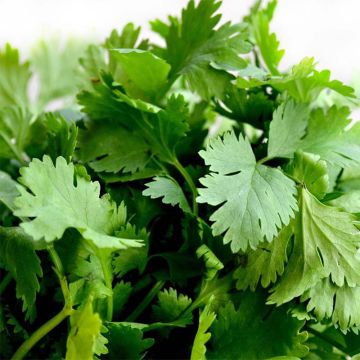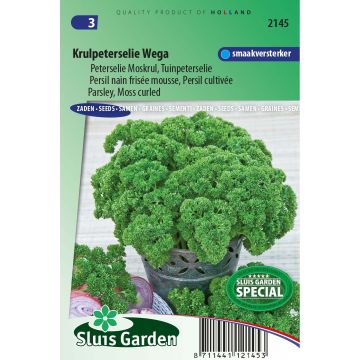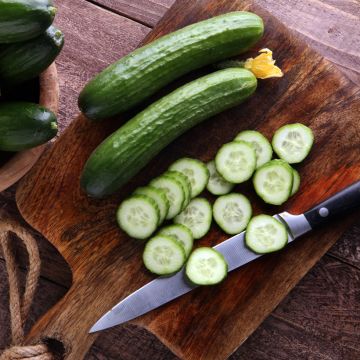

Persil frisé race Verbo (sélection Vilmorin) - Vilmorin
Curly Parsley Verbo - Vilmorin Seeds
Petroselinum crispum race Verbo
Garden Parsley, French Parsley
Special offer!
Receive a €20 voucher for any order over €90 (excluding delivery costs, credit notes, and plastic-free options)!
1- Add your favorite plants to your cart.
2- Once you have reached €90, confirm your order (you can even choose the delivery date!).
3- As soon as your order is shipped, you will receive an email containing your voucher code, valid for 3 months (90 days).
Your voucher is unique and can only be used once, for any order with a minimum value of €20, excluding delivery costs.
Can be combined with other current offers, non-divisible and non-refundable.
Why not try an alternative variety in stock?
View all →This plant carries a 6 months recovery warranty
More information
We guarantee the quality of our plants for a full growing cycle, and will replace at our expense any plant that fails to recover under normal climatic and planting conditions.
Description
'Verbo' Parsley is a curly-leaved variety selected by Vilmorin that is particularly fast-growing. It produces attractive, very frilly and dense dark green leaves on 40 cm high plants. It is a great cut-and-come again herb as it soon puts out new leaves after harvesting. Ideal for growing in pots! Sow from February to September and enjoy long harvests from May to November.
Parsley is a biennial aromatic plant, generally grown as an annual, native to the Mediterranean region. It belongs to the Apiaceae family and is widely used as a fresh culinary herb. There are two main types of parsley: Italian flat parsley which is considered to have a more robust flavour, and curly French parsley which is usually used as a garnish. Less common is Hamburg parsley, grown for its thick, parsnip-like taproots.
During its second year, parsley produces umbels of tiny yellowish-green to white flowers. The flower heads then develop seeds which can be harvested and dried for sowing the following year.
Parsley is very rich in vitamins A and C, trace elements and minerals. Parsley leaves can be eaten raw to flavour or garnish salads, or cooked in omelettes, soups and sauces. Save the stems for making bouquet garni, a French classic herb mixture used for flavouring casseroles, stews, stocks etc. that also includes thyme, rosemary and laurel leaves.
Harvesting: Parsley leaves can be picked all year round, simply snip the outer leaves off with scissors as and when required. Regular harvesting will encourage new leaf production.
Storage: Parsley has a fuller, richer aroma when eaten fresh. Nevertheless, the leaves can be frozen or dried for later use. To dry, hang in bunches upside down in a warm, well-ventilated room.
Good to know: Mulching with grass clippings or dead leaves is recommended, especially during hot dry spells, as this will help keep the soil moist whilst limiting weed growth.
Report an error about the product description
Harvest
Plant habit
Foliage
Botanical data
Petroselinum
crispum
race Verbo
Apiaceae
Garden Parsley, French Parsley
Cultivar or hybrid
Biennial
Other Herb seeds
View all →Planting and care
Sowing preparation: Before sowing parsley, it is necessary to prepare the soil by loosening it to a depth of a few centimeters and carefully weeding it. Parsley needs a lot of moisture to grow, so the soil should be watered generously or the seeds should be soaked in water for 24 hours before sowing. It can tolerate all types of soil but prefers those that are rich in humus and light.
Sowing in open ground: Parsley seeds can be sown directly in open ground from April to September. Whether sown in furrows or broadcast, or in a container, the seeds need a lot of moisture to germinate. They should be sown thinly in water-saturated soil and covered with half a centimeter of special seed compost, which should be firmly pressed down. Water should be added again to maintain constant moisture, and the sowing can be covered with a textile that can be watered. Germination can take a long time, up to one month.
Repotting: It is often necessary to have a ready-to-use pot of parsley for easy access. When your parsley plants are strong enough, take one or two of your seedlings from the garden. Place some gravel at the bottom of a pot to facilitate drainage. If necessary, loosen the roots and then adjust the root ball in its new container, filling it with moistened potting soil. Place your parsley in a sunny or semi-shaded location.
Seedlings
Care
Intended location
This item has not been reviewed yet - be the first to leave a review about it.
Similar products
Haven't found what you were looking for?
Hardiness is the lowest winter temperature a plant can endure without suffering serious damage or even dying. However, hardiness is affected by location (a sheltered area, such as a patio), protection (winter cover) and soil type (hardiness is improved by well-drained soil).

Photo Sharing Terms & Conditions
In order to encourage gardeners to interact and share their experiences, Promesse de fleurs offers various media enabling content to be uploaded onto its Site - in particular via the ‘Photo sharing’ module.
The User agrees to refrain from:
- Posting any content that is illegal, prejudicial, insulting, racist, inciteful to hatred, revisionist, contrary to public decency, that infringes on privacy or on the privacy rights of third parties, in particular the publicity rights of persons and goods, intellectual property rights, or the right to privacy.
- Submitting content on behalf of a third party;
- Impersonate the identity of a third party and/or publish any personal information about a third party;
In general, the User undertakes to refrain from any unethical behaviour.
All Content (in particular text, comments, files, images, photos, videos, creative works, etc.), which may be subject to property or intellectual property rights, image or other private rights, shall remain the property of the User, subject to the limited rights granted by the terms of the licence granted by Promesse de fleurs as stated below. Users are at liberty to publish or not to publish such Content on the Site, notably via the ‘Photo Sharing’ facility, and accept that this Content shall be made public and freely accessible, notably on the Internet.
Users further acknowledge, undertake to have ,and guarantee that they hold all necessary rights and permissions to publish such material on the Site, in particular with regard to the legislation in force pertaining to any privacy, property, intellectual property, image, or contractual rights, or rights of any other nature. By publishing such Content on the Site, Users acknowledge accepting full liability as publishers of the Content within the meaning of the law, and grant Promesse de fleurs, free of charge, an inclusive, worldwide licence for the said Content for the entire duration of its publication, including all reproduction, representation, up/downloading, displaying, performing, transmission, and storage rights.
Users also grant permission for their name to be linked to the Content and accept that this link may not always be made available.
By engaging in posting material, Users consent to their Content becoming automatically accessible on the Internet, in particular on other sites and/or blogs and/or web pages of the Promesse de fleurs site, including in particular social pages and the Promesse de fleurs catalogue.
Users may secure the removal of entrusted content free of charge by issuing a simple request via our contact form.
The flowering period indicated on our website applies to countries and regions located in USDA zone 8 (France, the United Kingdom, Ireland, the Netherlands, etc.)
It will vary according to where you live:
- In zones 9 to 10 (Italy, Spain, Greece, etc.), flowering will occur about 2 to 4 weeks earlier.
- In zones 6 to 7 (Germany, Poland, Slovenia, and lower mountainous regions), flowering will be delayed by 2 to 3 weeks.
- In zone 5 (Central Europe, Scandinavia), blooming will be delayed by 3 to 5 weeks.
In temperate climates, pruning of spring-flowering shrubs (forsythia, spireas, etc.) should be done just after flowering.
Pruning of summer-flowering shrubs (Indian Lilac, Perovskia, etc.) can be done in winter or spring.
In cold regions as well as with frost-sensitive plants, avoid pruning too early when severe frosts may still occur.
The planting period indicated on our website applies to countries and regions located in USDA zone 8 (France, United Kingdom, Ireland, Netherlands).
It will vary according to where you live:
- In Mediterranean zones (Marseille, Madrid, Milan, etc.), autumn and winter are the best planting periods.
- In continental zones (Strasbourg, Munich, Vienna, etc.), delay planting by 2 to 3 weeks in spring and bring it forward by 2 to 4 weeks in autumn.
- In mountainous regions (the Alps, Pyrenees, Carpathians, etc.), it is best to plant in late spring (May-June) or late summer (August-September).
The harvesting period indicated on our website applies to countries and regions in USDA zone 8 (France, England, Ireland, the Netherlands).
In colder areas (Scandinavia, Poland, Austria...) fruit and vegetable harvests are likely to be delayed by 3-4 weeks.
In warmer areas (Italy, Spain, Greece, etc.), harvesting will probably take place earlier, depending on weather conditions.
The sowing periods indicated on our website apply to countries and regions within USDA Zone 8 (France, UK, Ireland, Netherlands).
In colder areas (Scandinavia, Poland, Austria...), delay any outdoor sowing by 3-4 weeks, or sow under glass.
In warmer climes (Italy, Spain, Greece, etc.), bring outdoor sowing forward by a few weeks.




























































